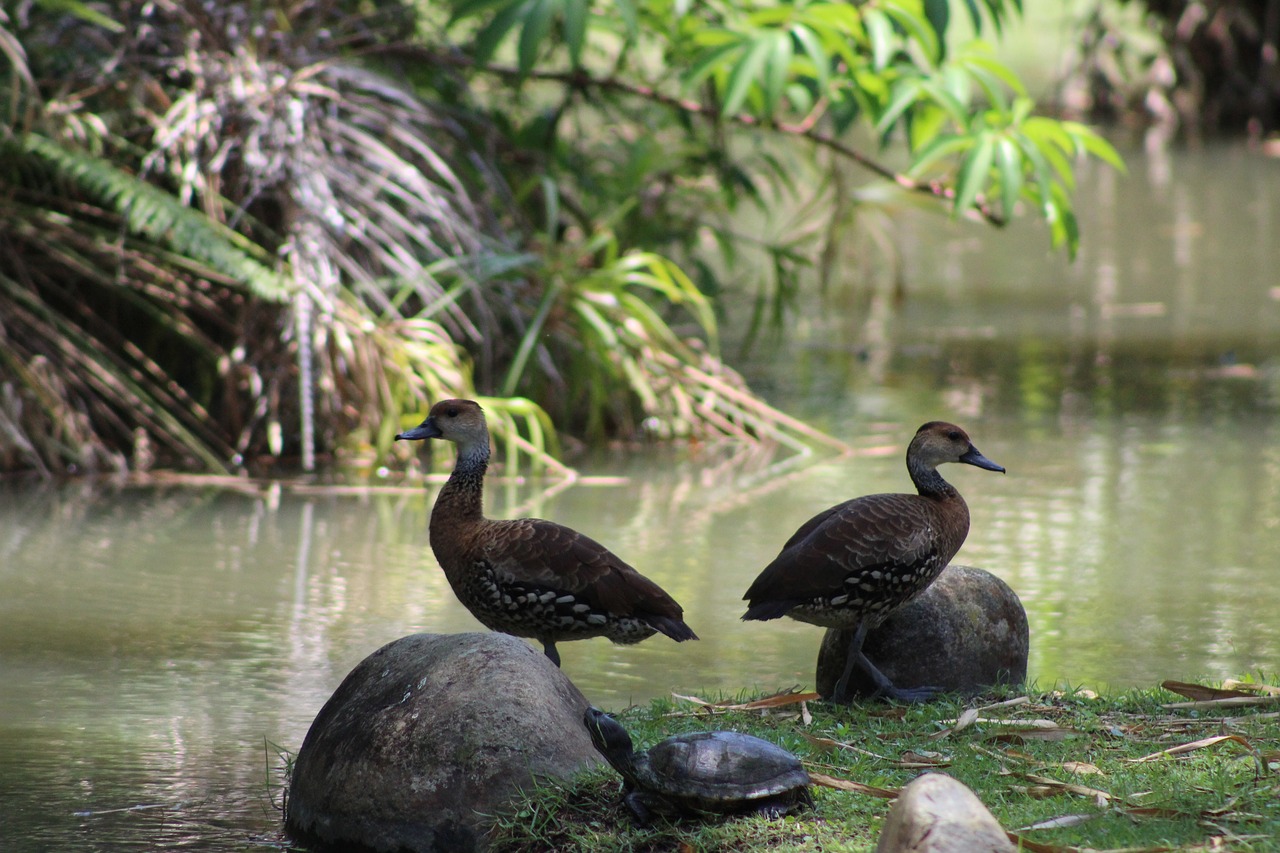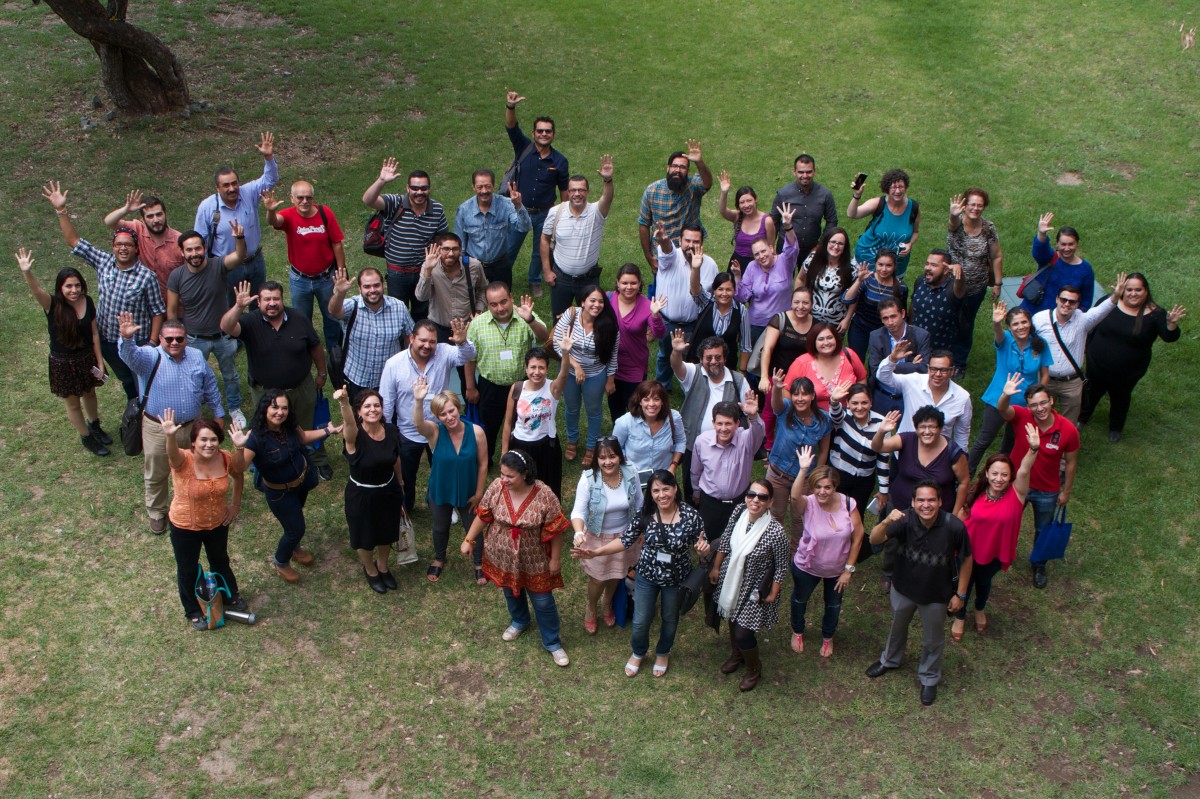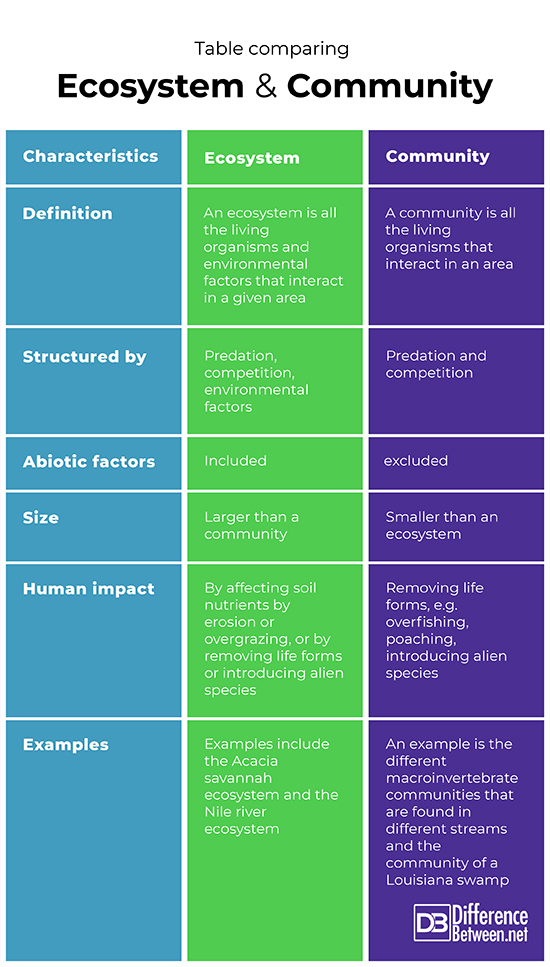Difference between Ecosystem and Community
An ecosystem is all the living organisms and environmental factors that interact within a given area. A community is only the living organisms that interact within a given area.

What is Ecosystem?
Definition of Ecosystem:
An ecosystem can be defined as a group of living organisms and all the abiotic environmental factors that they interact within a given area. Both the abundance of populations of each organism and the nature of the environmental factors, affect the ecosystem and can cause it to change. Humans can impact the ecosystem by altering the environmental factors or by removing or adding species.
Size of Ecosystem:
An ecosystem is larger than a community and actually includes a community plus environmental parameters that impact the community members. This means that besides the biomass of living organisms that is present, we are also concerned with the soil or water that plants and animals happen to be found in, and the associated nutrients and resources that are present.
Animal life:
All animals that are found in an ecosystem interact in some way directly or indirectly, and are affected by environmental factors such as nutrients in the soil or water. For example, a mayfly larva may be found in a stream where oxygen is high. This then is fed on by a dragonfly larva that is also adapted to fast-flowing water. Any change in oxygen level and other nutrients could impact these animals and therefore the entire ecosystem.
Trophic levels in Ecosystem:
There are trophic levels present in which energy flows from primary producers which are usually plants into consumers, which are animals. The energy taken in by the first consumer which feeds on the producers is passed through a food chain or food web into other animals or consumers when it is eaten by them. When the organisms die they return nutrients to the environment and thus also influence the abiotic factors of the ecosystem.
Examples of Ecosystem:
There are many types of ecosystems that are found in water and on land. For example, there is the Nile river aquatic ecosystem. In Africa, you can have an Acacia savannah ecosystem with all the life forms and soil making up this ecosystem.

What is Community?
Definition of a Community:
A community is a group of plants and animals that are found in a particular area that all interact in some way. The numbers and size of each population of each species of plant or animal strongly influence the community, and can cause it to change. Community ecologists focus on biotic interactions of fauna and flora. Humans can impact the community by removing or adding species.
Community Size:
A community is smaller in size than an ecosystem since it excludes abiotic factors. Therefore, a smaller entity is involved and the substrate that animals and plants live on or within is ignored.
Animal life:
Animals interact within the community either through predation or competition, which helps to determine the structure of the community. In other words, animals may compete to feed on plants, or for space. Different species also prey on other animals and help to regulate population sizes. For example, an owl can help control the number of rodents in an area by feeding on them. If there were no predators for the rodents, then there would be too many in the area.
Community Trophic levels:
The community also contains trophic levels and food webs with a flow of energy from producers up to consumers until a top predator is reached. Similar to an ecosystem, a community contains organisms that have different feeding modes such as herbivory, omnivory, and carnivory.
Examples of Community:
There may be a different macroinvertebrate community in one stream compared with another. Further examples would be, for instance, a community of birds, cypress trees, and all other organisms found living in a Louisiana swamp.
Difference between Ecosystem and ecosystem
-
Definition
An ecosystem is all the life forms and environmental factors found in a particular region. A community is all the life forms found in a particular region.
-
Structured by
The structure of an ecosystem is influenced by interactions among living organisms and also changes in environmental factors. The structure of a community is only influenced by biotic interactions such as predation and competition that occur among living organisms.
-
Abiotic factors
An ecosystem includes all the abiotic factors such as soil, water, and nutrients that influence the living organisms in the area. A community does not include any abiotic factors or their impact on living organisms.
-
Size
An ecosystem is larger than a community because it includes environmental factors, and a community is smaller than an ecosystem because it is only concerned with living organisms.
-
Human impact
Humans can impact ecosystems by introducing alien species, removing animals and plants, and by negatively impacting environmental resources through soil erosion. Humans can impact a community by removal of plant and animal life.
-
Examples
Examples of ecosystems include the Nile river ecosystem and the Acacia savannah of Africa. Examples of communities include the different macroinvertebrates found in different types of streams or the plants and animals of a Louisiana swamp.
Table comparing Ecosystem and Community

Summary of Ecosystem Vs. Community
-
- Communities and ecosystems both have living organisms present.
- An ecosystem includes all the plants, animals and life forms as well as abiotic environmental factors they interact with.
- A community only includes plants, animals and other life forms.
- Ecosystems are affected by changes to abiotic factors and interactions among living organisms.
- Communities are only affected by changes to biotic factors, such as predation and competition.
- Difference Between Rumination and Regurgitation - June 13, 2024
- Difference Between Pyelectasis and Hydronephrosis - June 4, 2024
- Difference Between Cellulitis and Erysipelas - June 1, 2024
Search DifferenceBetween.net :
Leave a Response
References :
[0]Reice, Seth R. "Nonequilibrium determinants of biological community structure." American scientist 82.5 (1994): 424-435.
[1]Image credit: https://pixabay.com/en/ecosystem-ducks-natural-animals-3712206/
[2]Image credit: https://pxhere.com/en/photo/195521
